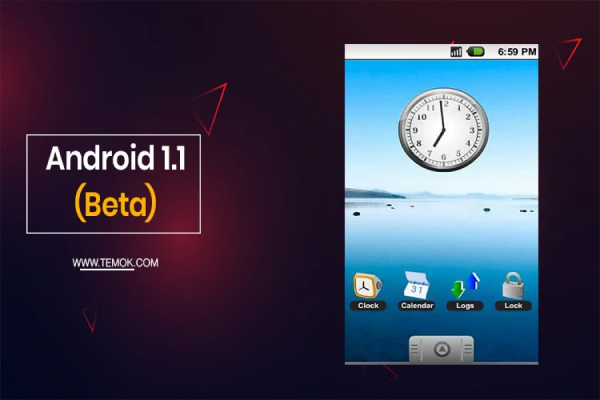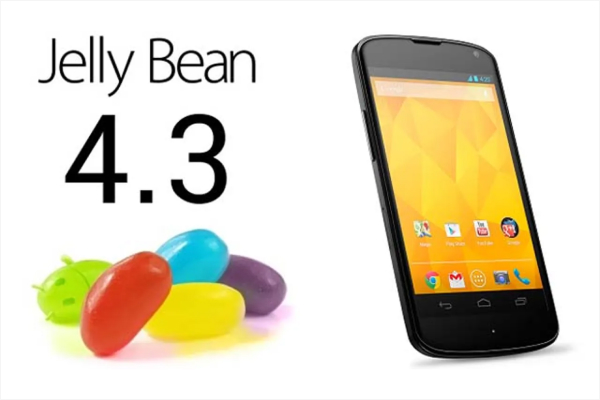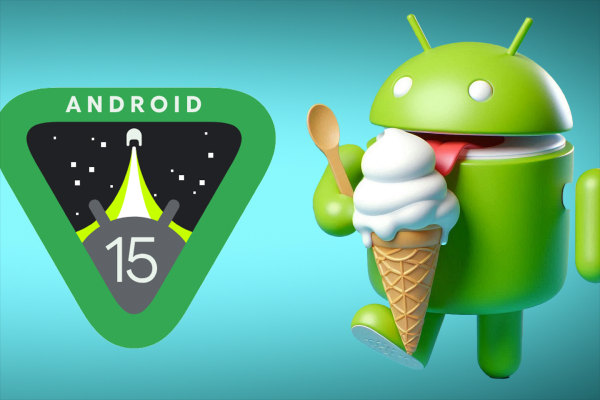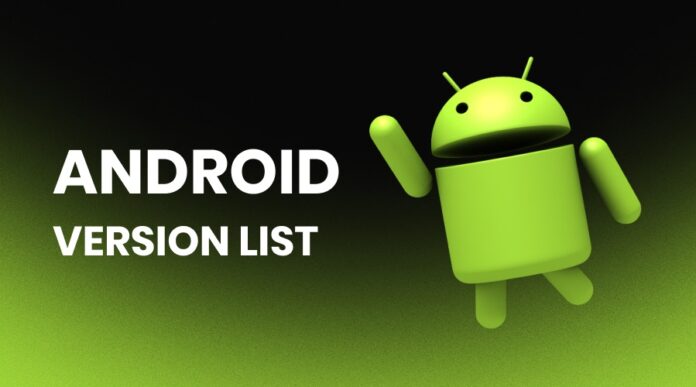With more than 3.9 billion users, Android is the dominant mobile operating system. It has a global market share of 72.17%, which is way too more than any other operating system. Since the first version of Android, Google has strived to make the software synonymous with innovation and advancement.
Currently, Android users are enjoying the benefits of Android 14 and waiting for the latest smartphone models designed with Android 15. But how about the earlier versions? Would you be interested in learning about them? If yes, then read this post. Here, we’re sharing a detailed guide with the complete history and features of Android from the first version to the fifteenth. Let’s get started….
Table of Content
- Android Version List: A Complete Guide From First To The Latest
- Android 1.0 Alpha
- Android 1.1 Beta
- Android 1.5 Cupcake
- Android 1.6: Donut (API 4)
- Android 2.0 Eclair (API 5)
- Android 2.2: Froyo (API 8)
- Android 2.3: Gingerbread (API 9)
- Android 3.0: Honeycomb (API 11)
- Android 4.0: Ice Cream Sandwich (API 14)
- Android 4.1 to 4.3: Jelly Bean (API 16)
- Android 4.4 KitKat (API 19)
- Android 5.0 Lollipop (API 21)
- Android 6.0 Marshmallow (API 23)
- Android 7.0: Nougat (API 24)
- Android 8.0: Oreo (API 26)
- Android 9: Pie (API 28)
- Android 10: Android Q (API 29)
- Android 11: Red Velvet Cake (API 30)
- Android 12: Snow Cone (API 31)
- Android 13: Tiramisu (API 33)
- Android 14: Upside Down Cake
- Android 15: Vanilla Ice Cream
Android Version List: A Complete Guide From First To The Latest
Here is our complete guide with all the Android versions until today. Read on for the history and features of all the Android versions. Here we go…
1. Android 1.0 Alpha
The first version of Android, called Android 1.0, was rolled out on September 23, 2008. However, Alpha and Beta were released before this version. Alpha failed as it had many challenges, including the necessity of hardware buttons or a physical keyboard. The first Android device that launched version 1.0 Alpha was the HTC Dream.
Features
- Google apps like Gmail, Calendar, Maps, and YouTube
- Wifi-Bluetooth support
- Limited features of the camera
- Instant text messaging and SMS
- Web browser
- Google search engine
- Notifications in the status bar with options to set ringtone or vibration alerts
2. Android 1.1 Beta

Android 1.1 Beta was launched on February 9, 2009. It was an improved version of Android 1.0. It resolved bugs and glitches of API 1. In addition, it added a number of features to enhance the user’s experience. Like before, it was also initially launched for the HTC Dream. It was also known as Petit Four.
Features
- Save attachments (PDF files, images, videos, etc.) in messages
- Feature to show/hide the dial pad
- Longer in-call screen when using the phone on speaker
- Know details and reviews of the locations with Google Map
- The marquee element in layouts added a fun function
3. Android 1.5 Cupcake
Another Android version that was launched after Android 1.1 Beta was 1.5 Cupcake. Based on Linux kernel 2.6.27, Android 1.5 Cupcake was launched on April 27, 2009. It introduced numerous refinements to the user interface and added more features to increase the user’s excitement. However, Google discontinued this version on June 30, 2017.
Features
- On-screen keyboard with user dictionary
- Third-party app widgets
- Copy and paste features
- Animation in transition added uniqueness
- Upload videos to YouTube
- Support of 3GP and MPEG-4 for video recording and playback
- One-touch access to contacts
- Edit anything and anytime
- Upload images to Picasa
4. Android 1.6: Donut (API 4)
The next version that Google launched after Cupcake was Android 1.6: Donut. Released on September 15, 2009, Android 1.6 immediately grabbed everyone’s attention. This is because Google launched it with numerous advanced features. Based on the Linux kernel 2.6.29, the Donut version provided an immersive experience to Android users.
Features
- Highly responsive and accessible camera
- WVGA screen resolutions
- Select multiple photos for deletion
- Multilingual speech to allow an Android application to speak text
- Fully functional search engines
- Advanced GestureBuilder development tool
- Add content in search results
- Support for VPNs, CDMA/EVDO, and 802.1x
- Text-to-speech search engine
5. Android 2.0 Eclair (API 5)
The next version of Android was 2.0 SDK Éclair. It was launched on October 26, 2009. Based on the Linux kernel 2.6.29, this software came packed with some innovative elements, especially for the camera like digital zoom, color effect, flash support, white balance, scene mode, and macro focus.
Also, the users found it the most fascinating version to date because of the addition of live wallpapers. It allowed the animated images of the home page to show real-time movements. Overall, it was a new phase in the history of Android.
Features
- Add multiple accounts for a nice synchronization of contacts and an email
- Support of Bluetooth 2.1 and HTML5
- Automatic deletion of old messages when the messages exceed the limit of the message box
- Easy to search saved SMS and MMS messages
- Incredible camera features for personalized photos and videos
- Speed improvement for on-screen keyboard
- Better contrast ratio
- Improved Google Maps abilities
- Enhanced features of Calendar
- Tap a Contact photo to call and send an SMS or email
- Upgraded browser UI
- Pinch-to-zoom capability
6. Android 2.2: Froyo (API 8)
Next, in 2010, Android released Froyo Android 2.2 (API8). Froyo Android 2.2 (API8) was released on May 20, 2010, with the support for a 320ppi screen pixel display. It claimed to provide the fastest browser among other smartphones in 2010.
The most notable feature of this version was that API 8 was 2.5x faster, smarter, and more productive than its former versions. It was launched with the integration of Chrome’s JavaScript engine Android Cloud to Device Messaging. This way, it gave every reason for developers to go beyond possibilities and limitations.
Features
- Speed and performance improvements
- Push notifications
- Seamless switch between multiple keyboard languages and their dictionaries
- Adobe Flash support
- View pictures with the feature of zoom’
- Animated GIFs in various frames
- Ability to disable data access over the device
- Enhanced security features (eg. numeric and alphanumeric passwords)
- Wifi and USB-tethering support
- Bug fixes
7. Android 2.3: Gingerbread (API 9)
In the same year as Froyo, Google launched another version, i.e., Android 2.3 Gingerbread. Google launched it on December 6, 2010, with support for Linux kernel 2.6.35 and API 9. Most importantly, it came with graphics, audio, and input enhancements for developers. This made it an ideal software, especially for the ones who loved to indulge in modern games.
Features
- Intuitive user interface with easy navigation
- Extra-large screen and powerful resolutions
- Fast text and voice input on an on-screen keyboard
- Improved copy or paste functionalities
- Multiple cameras (with front-facing camera)
- Easy access to downloaded files
- Equipped with advanced sensors such as barometers and gyroscopes
- Power-consumption management
- Advanced support for game developers
- Intriguing audio effects such as equalization, headphone virtualization, etc.
- Great support for SIP VoIP internet telephones
8. Android 3.0: Honeycomb (API 11)
The next version was Android 3.0: Honeycomb (API 11). Built with innovative connectivity features, Android 3.0 Honeycomb was released in 2011. Significantly, it was launched for larger screen-sized devices like tablets to redefine the experience of users and developers. It came with advanced features, i.e., seamless multitasking, home page customizations, widgets, and more. Users loved this version the most because it offered them an unforgettable 3D experience to interact and enjoy more.
Features
- Intuitive and customized UI
- Powerful graphics
- Robust media player capabilities
- Seamless navigation buttons in the system bar
- Customize the home screen with widgets, app shortcuts, and wallpapers
- Smooth multitasking
- Speed improvements in the virtual keyboard
- Copy, paste, share, find, and explore
- Support for Media/Picture Transfer Protocol
- Enhanced wi-fi functionality
- Better browser experience
- Integrated with the advanced support for time-lapse video recording
- Built-in support of a two-pane UI and Fast Scroll for the Contacts app
- Redesigned UI widgets and themes
- Rich notifications
- Persistent action bar for application control
- More sensor enhancement
- Talk video chat
- Google eBooks
- Advanced 3D user interface
- High-performing 2D and 3D graphics
- Support HTTP media streaming
- Compatible with apps available on the Google Play Store
9. Android 4.0: Ice Cream Sandwich (API 14)
In the same year, Google launched another version, i.e., Android 4.0: Ice Cream Sandwich (API 14). With the launch of Android 4.0: Ice Cream Sandwich on October 19, 2011, Google entered the era of minimalistic design and evolving user interface. The internet was buzzed with its release because of its exclusive features, resizable widgets, personalized home screen, robust web browsing, face unlocking, unified user interface, full-resolution snapshots, and more.
Features
- Camera features like ZSL exposure, image zoom, and continuous focus
- Face detection technology
- Customized image effects to transform videos and images
- Lag-free camera
- Support of WebP format for high-quality compressed images
- Built-in support of Khronos OpenMAX AL 10.1 for low-level streaming
- Ability to open up to 16 tabs simultaneously in the browser
- Redefined 2D and 3D graphics
- Rich notifications
- Exchange apps, media, and contacts with NFC-based sharing
- Unified calendar
- Visual voicemail features voice transcriptions and audio files
- Link social groups, contacts, and profiles together
- Exceptional voice input engine
- Spell checker
- Respond by text messages
10. Android 4.1 to 4.3: Jelly Bean (API 16)

The next Android version was Jelly Bean. Known as Jelly Bean, a sweeter version of Android was launched in June 2012 to build faster, smoother, and more responsive smartphones. It added new optimization features to the device, such as triple buffering, powerful 2D graphics, zero touch-sensor latency, etc.
Features
- Vsync timing
- High-performing 2D and 3D graphics to enhance gaming capabilities
- Set up separate environments for each user with restricted profiles
- More sensor capabilities
- Handle quick responses
- High-quality shapes and text
- Improved window buffer allocation
- Advanced visual effects
- Project butter
- Enhanced camera functionalities
- 4k resolution support
- Expandable notification bar
- Efficient power consumption
- Multiple language support
- Security features
- Set or adjust the volume of calls or message ringtones
- Built-in emoji support
- Accessibility features
11. Android 4.4 KitKat (API 19)
On September 3, 2013, Google launched Android 4.4 KitKat for the Nexus 5. Later, it was available for other devices. Kitkat was designed to enhance the user experience. Furthermore, it worked better with less RAM than before.
Features
- Full-screen artwork when the device is locked and the music is playing
- GPS support
- Organized user interface
- Full-screen immersive experience
- Screen recording
- Seamless change in resolution during playback
- Offline music support
- Smart caller ID
- Real-time updates for Google map navigation and alarm
- Contact prioritization
12. Android 5.0 Lollipop (API 21)
The next Android version was 5.0 Lollipop. Launched on November 12, 2014, Android 5.0 Lollipop was packed with new and advanced features. It was not limited to phones, tablets, and wearables; users could integrate it with their TVs and cars as well. Also, Lollipop has many exciting, innovative, and unique features.
Features
- Apps on a larger screen of the Android TV
- Multi-networking features
- High-performance graphics
- Low-latency audio
- Enhanced camera and video performance
- Screen capturing and screen sharing
- Work with more sensors
13. Android 6.0 Marshmallow (API 23)
In August 2015, Google launched the Android 6.0 Marshmallow or API Level 23, the next Android version. It brought several major improvements and features to the Android operating system. It was primarily released to improve the user experience.
Nexus 5 and Nexus 6 were the first devices to receive the update on October 5, 2015. Android 6.0 Marshmallow established a framework for enhanced user control over permissions, improved battery management, and strengthened security, with many of these features paving the way for future developments in subsequent Android versions.
Features
- Fingerprint authentication
- Type C USB support
- Automatic full data backup
- Custom Gooogle tabs
- Auto backups for apps
- 4K display mode
- Multi-window experience
- Clear permission system
14. Android 7.0: Nougat (API 24)
Another version that Google launched was Android 7.0: Nougat or API level 24. Android 7.0 Nougat was released in 2016 with a blend of features and robust strength. It brought substantial improvements to the Android ecosystem with a focus on user experience, performance, and productivity.
Android 7.0 Nougat was launched with a focus on user productivity, multitasking, and power efficiency. With features like multi-window support, advanced notifications, data-saving tools, and Vulkan graphics support, it provided a smoother, more versatile, and powerful Android experience, setting a strong foundation for future Android versions.
Features
- App shortcuts
- Image keyboard support
- New professional emoji
- Enhanced live wallpaper
- Low latency in the VR mode
- Multi-endpoint calling
- Split screen mode
- Data functionality
- Display touch sensor enhancement
15. Android 8.0: Oreo (API 26)
Android 8.0 Oreo was released in August 2017 with more features and functionalities for users and developers. It introduced several key features and optimizations. Android Oreo focused on streamlining the user experience, improving battery life, enhancing security, and adding new features that made multitasking and productivity easier.
Features like Picture-in-Picture, Notification Channels, and Autofill set a foundation for a more efficient Android experience, while Play Protect and Background Execution Limits reinforced device security and performance.
Features
- Support for picture-in-picture mode
- Easy to manage notifications and settings
- Auto-filling of login details
- Multi-tasking
- Wide-gamut color display
- Pin widgets and shortcuts
- Multi-display support
- Unified layout
- Android TV launcher
- Text-to-speech support
- Highly accessible
- Downloadable fonts
- New emoji styling
- Adaptive icons
- Auto-enable wi-fi
- Smart-text selection
16. Android 9: Pie (API 28)

Google launched the ninth version of Android, known as Pie, in August 2018 with plenty of amazing features to enhance the experience of users and developers. Android 9 Pie focused on enhancing the user experience through AI-driven features like Adaptive Battery and Adaptive Brightness, introduced tools to promote healthier device habits with Digital Wellbeing, and improved system efficiency and security. These changes set a new standard for smarter, more personalized, and secure smartphone use.
Features
- Easy navigation
- Edge–to-edge screens
- Enhanced messaging experience
- Multi-camera support (compatibility for external camera)
- Flash support
- Support for GIF and WebP
- HDR-enabled videos and movies
- Adaptive battery
- Volume enhancement
- Improved security features for data protection
- Easier screen rotation
- Accessibility menu
- Customized notifications and settings
- Decode images
- Biometric authentication
- Support for multiple formats, including HTML
17. Android 10: Android Q (API 29)
Google released the 10th version of Android on September 3, 2019. Android 10, also known as Android Q or API level 29, was launched with a focus on security enhancement, user experience, and accessibility, along with several key interface updates. One of the most notable features introduced with Android 10 was the system-wide dark mode. This allowed users to apply a dark theme across the OS and compatible apps, offering visual comfort and battery savings on OLED screens.
Features
- Improved biometric authentication settings
- Wi-fi network support
- Call screening
- Caller ID functionality
- Improvements in creating files in the external storage memory
- Accessibility menu
- Better notification settings
- Audio playback support
- Low-latency wi-fi
- Call quality improvement
- Monochrome camera support
18. Android 11: Red Velvet Cake (API 30)
Android 11, or API Level 30, was launched in September 2020 and codenamed “Red Velvet Cake.” With an enhanced user-centric approach and privacy features, Android developers launched this update to offer a mesmerizing user experience.
It offered a new conversation notifications section to group all message alerts, making it easier for users to manage conversations across apps. Additionally, it had a Bubbles feature that allowed users to multitask while keeping conversations accessible. Also, Android 11 featured improved media controls with a persistent playback bar, supporting seamless switching between audio devices.
Features
- Scrolling screenshots
- Improved autorotation
- Easy data sharing
- Smart Device Controls
- Support for waterfall displays
- Wireless debugging
- Multiple refresh rates
- Expanded camera support
- Chat bubbles
- Muted notifications during media streaming
- Notification history
- App and widgets pinning in the shared menu
- Improved one-time permissions
- Face unlock for pixel 4
- Undo of cleared applications
- Increased touch sensor
- Auto-revoke permissions
19. Android 12: Snow Cone (API 31)
The twelfth version introduced by Google is known as Snow Cone or API level 31. It had an exhaustive list of features like a modern user interface, redesigned widgets, AppSearch, Game mode, and new codecs.
These features made it radically different from the previous version. Released in October 2021, Snow Cone brought one of the most visually striking updates with its Material You design. The new update was known for offering dynamic color themes, allowing users to create a highly personalized interface.
Features
- Game mode APIs
- Rich content insertion
- Overview suggestions
- App hibernation
- Smooth motion
- Better dashboard
- Immersive gaming effects
- AppSearch
- Support for multi-languages
- Picture-in-picture mode
- Low-latency support
- Immersive mode improvements
- Privacy dashboard screen
- Bluetooth applications
- Phishing detection support for Pixel devices
- Modern codecs
- Easy color filters, blurs, and other effects
- Animated images
- Identify callers
- Revamped notifications
- One-handed mode
- Full-text search capabilities
20. Android 13: Tiramisu (API 33)
In August 2022, Google launched the Android 13 or API level 33, nicknamed “Triamisu.” It was the most powerful and aesthetic operating software to date. Combined with subtle features, this version offered an enhanced modern user experience with a focus on personalization, security, and cross-device compatibility.
Built on Android 12’s Material You design, Android 13 allowed users to extend dynamic color themes to more app icons, achieving a consistent look across the device. Additionally, it had privacy controls, multilingual support, and Bluetooth Low Energy Audio, which made Android 13 a versatile Android version.
Features
- Themed app icons
- Ideal for multilingual users
- Improved text support
- Predictive back gesture
- Low-energy audio
- Share and broadcast audio to friends and family
- Promotes a long battery life
- Increased resolution for controllers
- Efficiency of animated splash screens
- Users can select specific images to share with the app
- Standardized user interface for apps
- HDR video capture
- Spatial audio experience
- High accessibility
- Native LE Bluetooth support
- QR code scanner support
- Improved data security and privacy features
- New camera features
21. Android 14: Upside Down Cake
Google released Android 14 in October 2023. Initially, it was launched for Google Pixel devices. Later on, the developers launched it for Samsung and other smart devices. With Android 14, Google introduced numerous exciting features and enhancements.
One of the key updates was support for Ultra HDR, which enhances both HDR video and images, offering more vibrant colors, brightness, and contrast. Additionally, there are features for AI-powered wallpaper customization and lock screen customization, offering a more user-friendly and safe user experience.
Features
- Anti-phishing email detection
- App background battery usage settings
- Easy to share wi-fi password
- Per-app screen recorder
- Clock app
- Weather forecast
- Battery cycle counter
- A new lock screen style
- Universal drag-and-drop support
- Easy multitasking
- More vibrant and radiant colors
- Transparent navigation bar
- Easy to hide phone’s PIN from shoulder surfers
- Different live wallpapers for the home and lock screen
- Visual notifications via flash and screen cues
- Supports automatic confirmation of PIN without hitting the enter
- Emoji wallpapers to pixel
- Regional preferences feature
- Better support for keyboards
- Touchpad gestures
- Modifier key remapping
- Predictive back gesture
- App compatibility
- Background process optimization
- Better passkey support
- Health Connect
22. Android 15: Vanilla Ice Cream

Finally, Google launched Android 15, codenamed “vanilla ice cream,” with numerous advanced features and enhancements. It was launched in September 2024. Some of its advanced features include AI-driven privacy enhancements, improved security features (with app permission handling and data protection tools), enhanced desktop mode for better multitasking and window management, and so on.
This operating system also focuses on cloud integration and app archiving to help users manage storage. This update is currently exclusive to Google Pixel 6 and newer models. However, the brand plans to release it for other brands in the future. Some of the brands that can include Android 15 include Samsung, Honor, iQOO, Lenovo, Motorola, Nothing, OnePlus, Oppo, Realme, Sharp, Sony, Tecno, Vivo, and Xiaomi.
Features
- Performance settings
- Game mode API
- Improved battery performance
- More accurate benchmarking
- Power efficiency mode
- Improved workload management
- Subtle vibrations when adjusting display brightness
- Swipe up to continue is an innovative feature for foldable devices
- Boost camera preview brightness
- Low light enhancement while shooting videos or clicking pictures
- Bluetooth popup dialog
- Partial screen sharing
- Native app archiver
- Share or record an app or a window
- Integration of more features and insights in Health Connect
- MIDI keyboards to extend communication between music apps
- Accessibility to battery insight settings
- Auracast for audio sharing
- Edge-to-edge display for apps
- Immersive viewing experience
- Smaller cover screen support for foldable devices
- Tap-to-pay experience
- Screen record detection
- HDR headroom setting to combat issues like HDR and SDR support
- Support for loudness control
- Automatic activation for spatial audio
- More customized options
- Boost password-protected files
- Automatic language switching
- Enhance IntentFilter functionality
- Elegant fonts and style
- Smart home connectivity
Also Read: Android 15 vs iOS 18
Wrapping It Up
So, this is all about the Android versions till date. Android, as we said earlier is the most used operating system. Most phone models come integrated with Android OS. With each update, the brand promises a new set of enhancements and features to change the way how we interact with smartphones. With a focus on security, customization, better battery life, and gaming experience, they move one step ahead to make the impossible possible in the real world. Hopefully, it has been an enlightening read for you. Thanks for reading! Stay tuned for more such insightful posts!

